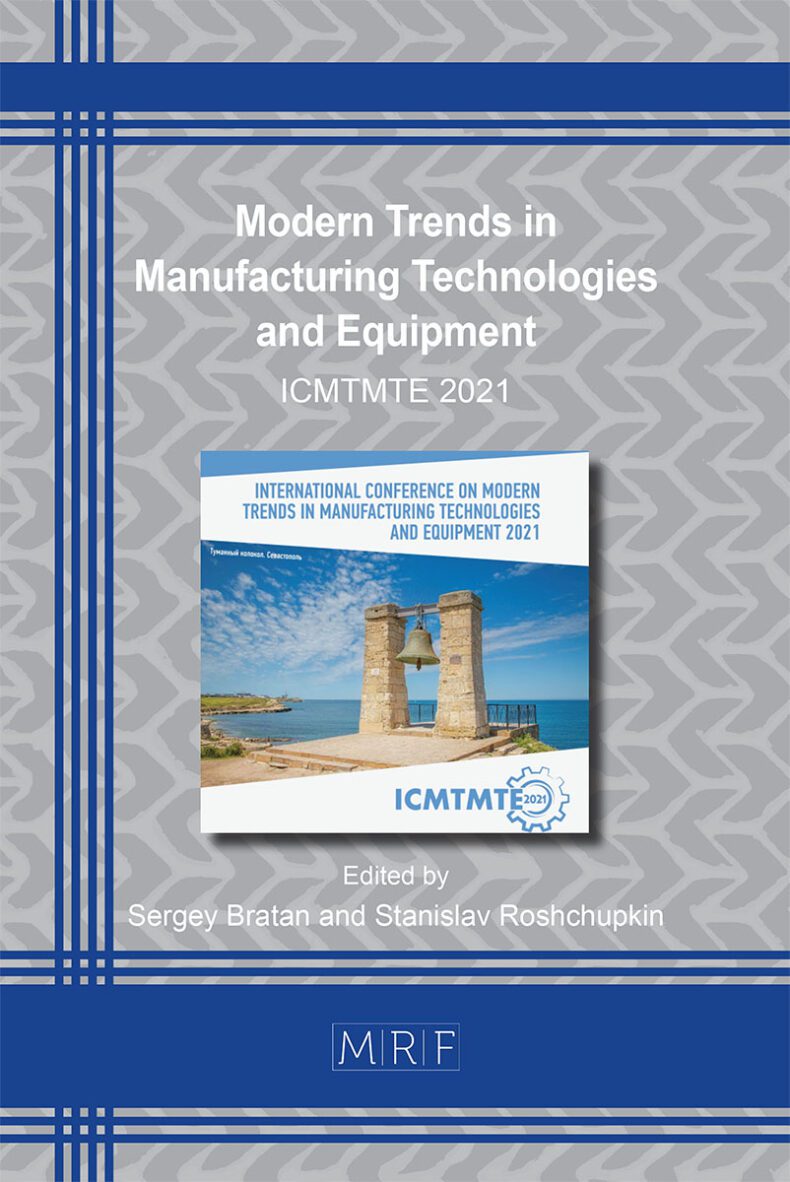Development of an Experimental Robotic Complex for Direct Metal Deposition and Testing of Deposition Modes for Heat-Resistant Powder Material
Maxim Oleynik, Alexander Khaimovich, Andrey Balyakin
download PDFAbstract. The paper considers the issue of optimizing the movement of an industrial robot used in additive manufacturing in the technology of direct metal deposition of parts. The developed mathematical model that takes into account the joint work of a six-axis robot manipulator and a two-axis positioner is described. The algorithm for calculating the motion based on the relative position of two adjacent points of the working tool trajectory relative to the rotary axis of the positioner with a given accuracy is described. The simulation of processing is carried out both when working only with the manipulator, and when working together with a two-axis positioner, and control programs with recalculated coordinates and rotation angles of the positioner are obtained.
Keywords
Industrial Robot, Tilt-And-Turn Device, Direct Metal Deposition, Optimization
Published online 1/5/2022, 9 pages
Copyright © 2022 by the author(s)
Published under license by Materials Research Forum LLC., Millersville PA, USA
Citation: Maxim Oleynik, Alexander Khaimovich, Andrey Balyakin, Development of an Experimental Robotic Complex for Direct Metal Deposition and Testing of Deposition Modes for Heat-Resistant Powder Material, Materials Research Proceedings, Vol. 21, pp 349-357, 2022
DOI: https://doi.org/10.21741/9781644901755-61
The article was published as article 61 of the book Modern Trends in Manufacturing Technologies and Equipment
![]() Content from this work may be used under the terms of the Creative Commons Attribution 3.0 licence. Any further distribution of this work must maintain attribution to the author(s) and the title of the work, journal citation and DOI.
Content from this work may be used under the terms of the Creative Commons Attribution 3.0 licence. Any further distribution of this work must maintain attribution to the author(s) and the title of the work, journal citation and DOI.
References
[1] Nof S. Y. Handbook of Industrial Robotics, 2nd ed. New York: John Wiley & Sons, 1999, p. 1378. https://doi.org/10.1002/9780470172506
[2] V. F. Filaretov, A.V. Zuev, A.S. Gubankov, Manipulators control when performing various technological operations, (in Russian). Moscow: Nauka, 2018, p.229.
[3] A.A. Ivanov, “Industrial robots in welding production” in Innovative mechanical engineering, Moscow, 2013, no. 4, pp. 22-25.
[4] R.R. Gabitov, I.I. Khabibullin, “Assessment of the possibility of robotic welding of the low-pressure turbine support body” in Molodezhnyi vestnik UGATU, Ufa, 2020, no. 2, pp. 19-22.
[5] E.A. Drobina, “Intelligent control system of a robotic-controlled painting complex” in Innovative development of science and education, collection of articles of the IX International scientific-practical conference: in 2 parts, Penza, 2020. pp. 93-95.
[6] Y.G. Kozyrev, Application of industrial robots, Moscow: KNORUS, 2010, 488 с.
[7] Robotic-Assisted Surgery [Online]. Available: https://www.intuitive.com/en-us, Accessed: 2020, Sep. 15.
[8] T. Cvitanic, V. Nguyen, S.N. Melkote, “Pose optimization in robotic machining using static and dynamic stiffness models” in Robotics and Computer-Integrated Manufacturing Volume 66, 2020. https://doi.org/10.1016/j.rcim.2020.101992
[9] A.V. Balyakin, V.A. Demenok, V.P. Kurbatov, “Influence of processing by milling on the surface layer of titanium alloy VT20 obtained by the method of direct laser growth” in Modern high technologies, 2018, no. 6, pp. 14-19.
[10] P. Xu, et al. Novel hybrid robot and its processes for precision polishing of freeform surfaces in Precision Engineering Volume 64, 2020, p. 53-62. https://doi.org/10.1016/j.precisioneng.2020.03.013
[11] Institute of Laser and Welding Technologies [Online]. Available: http://ilwt-stu.ru, Accessed: 2020, Sep. 16.
[12] Khaimovich A.I., Stepanenko I.S., Smelov V.G., Optimization of selective laser melting by evaluation method of multiple quality characteristics // IOP Conference Series: Materials Science and Engineering, С. 012067. p. 7, 2018. https://doi.org/10.1088/1757-899X/302/1/012067
[13] S.P. Murzin at al., “Creation of technology for high-speed manufacturing of parts and components of aircraft engines by methods of heterophase powder metallurgy: Report IiI on the component of applied research and experimental development”, Samara, 2016, p. 350.
[14] Glukhov V.V., Turichin G.A., “Economic efficiency of direct laser sintering technology in industry”, in Theoretical foundations of industrial policy formation. St. Petersburg: Peter the Great St. Petersburg Polytechnic University, 2015, pp. 176-190.
[15] Bykovsky D.P., et al., “Application of direct laser sintering technology for the manufacture of stainless steel samples and investigation of their mechanical properties”, in Additive technologies: present and future, collection of reports of the II International conference, Moscow, 2016.
[16] CAD/CAM/CAE Observer #6 (50) / 2009 [Online]. Available: http://www.cadcamcae.lv, Accessed: 2020, Sep. 16.
[17] S.L. Zenkevich, A.S. Yushchenko, “Fundamentals of manipulation robots control”, Moscow: MGTU, 2000. p. 400.
[18] Peng J., et al., Smoothness-oriented path optimization for robotic milling processes // Science China Technological Sciences, 2020, p. 15. https://doi.org/10.1007/s11431-019-1529-x
[19] Huynh H., et al. Modelling the dynamics of industrial robots for milling operations // Robotics and Computer-Integrated Manufacturing Volume 61, 2020, p. 16. https://doi.org/10.1016/j.rcim.2019.101852































